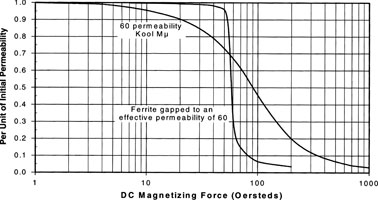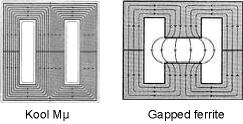
Kool Mμ powder cores from Magnetics are made of a ferrous alloy powder (Al, Si, Fe composition), which has low losses at elevated temperatures. Kool Mμ E-cores have a distributed air gap that makes them ideally suited for switching regulator inductors, flyback transformers, and power factor correction (PFC) inductors. The 10 500 gauss saturation level of Kool Mμ provides a higher energy storage capability than can be obtained with gapped ferrite E-cores, resulting in smaller core size.
Kool Mμ E-cores are competitively priced against gapped ferrite E-cores and their distributed air gap eliminates gap loss problems associated with ferrites. These cores also have significantly lower losses and substantially better thermal properties when compared to powdered iron E-cores.
Materials and DC bias
Kool Mμ E-cores are available in four permeabilities, 26 μ, 40 μ, 60 μ, and 90 μ. The most critical parameter of a switching regulator inductor material is its ability to provide inductance, or permeability, under DC bias. Figure 1 shows the reduction of permeability as a function of DC bias. The distributed air gap of Kool Mμ results in a soft inductance versus DC bias curve. In most applications, this swinging inductance is desirable since it improves efficiency and accommodates a wide operating range. With a fixed current requirement, the soft inductance versus DC bias curve provides added protection against overload conditions. Figure 1 is plotted on a semi-log scale to show the DC bias characteristics at high currents.

Comparisons
With more than twice the flux capacity of ferrite, Kool Mμ offers significantly better DC bias characteristics (Figure 2). At a typical 50% roll-off, this can result in a 35% reduction in core size and a more robust design that utilises the soft saturation of Kool Mμ. The flux capacity difference is even more dramatic at high temperatures, since the flux capacity of ferrites decrease with temperature while Kool Mμ stays relatively constant.

Although high grade ferrite core losses are lower than Kool Mμ core losses, ferrite often requires low effective permeability to prevent saturation at high current levels. Ferrite, with its high initial permeability, requires a relatively large air gap to get a low effective permeability. This large air gap results in gap loss, a complex problem which is often overlooked when comparing material loss curves. Simply put, gap loss can drastically increase losses due to fringing around the air gap (Figure 3). The fringing flux intersects the copper windings, creating excessive eddy currents in the wire. Gapped ferrite cores do have advantages over Kool Mμ E-cores. Gapped ferrites typically have a ±3% tolerance on inductance compared to Kool Mμ's ±8%. Gapped ferrites are available in a much wider selection of sizes and shapes.

Since ferrites can have a higher gapped effective permeability, it is well suited for relatively low bias applications, such as feed forward transformers and low biased inductors.
Kool Mμ, (Al, Si, Fe composition) offers similar DC bias characteristics when compared to powdered iron (pure Fe composition). Kool Mμ's advantage over powdered iron is its lower core losses. In addition to withstanding a DC bias, switching regulator inductors see some AC current, typically at 10 kHz to 300 kHz. This AC current produces a high frequency magnetic field, which creates core losses and causes the core to heat up. In addition to lower core losses, Kool Mμ has near zero magnetostriction, eliminating the audible noise associated with powdered iron cores, ferrite, or silicon iron laminations when they are operated in the 20 Hz to 20 kHz range.
With a Curie temperature of approximately 500°C and rated for continuous operation from -65 up to +200°C, Kool Mμ also offers excellent performance over temperature.

© Technews Publishing (Pty) Ltd | All Rights Reserved